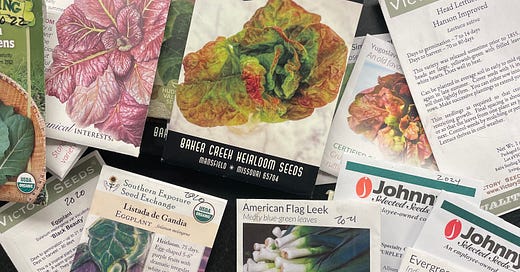January's a happy time for gardeners
It begins with reviewing the wins and losses of last summer, then planning -- and dreaming -- kick in.
As someone who likes to garden, this is one of my favorite times of the year. This may seem odd. The temperature outside my home today is 17 degrees and 14-20 mph wind gusts are howling out of the north. The ground is a rock. Nothing grows. Even plants with green leaves still on them are shriveled.
With nothing to do outdoors except gather wood from the pile or search for kindling in the woods, I turn my focus inward, and with that comes optimism.
January is the month on the garden calendar when everything is possible. I can close my eyes and see neat rows of lettuce and tomatoes reaching out of the warm soil for the midsummer sun. I see veronica, catmint and daylilies swaying in the breeze in the perennial borders and cosmos and zinnias flashing orange and yellow in the cutting garden.
To get to this happy place, though, I need to plan. And to plan I first need to look back at last year’s growing season and tally the wins and losses. What worked, what didn’t, what earned a return to the garden and what is more deserving of exile.
Six years ago I started using a journaling app called Day One. For me this app is an essential companion. As I make my way through the garden each day, I tap out or dictate notes and snap photographs, reminding me where I planted things and providing a first draft of the history of what unfolded during the growing season. It organizes entries chronologically, as well as with hashtags and keywords, all of it searchable. Plus it includes photos. It’s become an invaluable record-keeping tool.
What did I learn from the summer of 2024?
I really like a new variety of kale called Meadowlark that I grew for the first time. Kohlrabi and turnips are not worth the effort or the space they took up in the garden, at least for me. I had mixed success growing Bok Choy and Tatsoi, two wonderful Asian greens, so I’m not sure I’ll plant them again. The celery, beets and leeks grew just well enough to encourage me to bring them back for another season, albeit with a more determined effort to improve their performance. I was reminded that spinach grows great here in western Massachusetts, where the summer is not as plagued by heat and humidity as it is back in my former gardening home outside Washington, DC. We were able to harvest spinach from spring into early summer and again late into the autumn. My belief in growing tomatoes in straw bales was strengthened, though I’m not sure I’ll plant dwarf varieties any longer. They’re perfect for small spaces like patios, have great flavor and the fruit is well sized, but I don’t see any advantage over growing indeterminate heirloom varieties.
[Here’s my post from last year about straw bale gardening.]
[This is my post on why I started growing dwarf tomato varieties.]
My biggest failure was watering. I was aware of the lack of rainfall the second half of last summer but was slow to react to it as it turned into a full blown drought. The blame falls solely on me, due to a combination of simple inattention or hubris about my heavily composted soil’s water-holding capability. I will pay more attention this summer and in the years ahead, especially as weather patterns change. My greatest frustration was the damage many plants suffered from pests, foremost among them cabbage worms. This particularly affected their favorite targets – brassicas such as brussels sprouts, kale, cabbage and collards. I’m not sure what to do about it except try to control the pests by hand picking or organic spraying (BT is the best choice) and to encourage more beneficial insects and birds to stop by for snacking.
With these lessons learned, I again turn my attention to my seed collection. I have a spreadsheet with every vegetable, herb and flower seed packet listed on it, along with the year I bought them and from which company. It also includes helpful information on germination times and planting dates and recommended spacing in the garden. I note those seeds that need to be restocked and those past their prime germination dates.
We’ve also done a little more seed saving this year. I have a collection of butternut squash seeds I recently saved from one we bought at a local organic farm. They’re dried and ready to be put in an envelope. We’ve also saved seeds from poppies, verbena, balloon flowers, coneflowers, Joe Pye weed and Jimmy Nardello peppers.
January is the month my inbox fills with emails from seed companies letting me know their 2025 seeds are now available. The arrive with subject lines like:
“What seeds are hot in January?”
“Grow your own big, juicy onions”
“New & unusual varieties for 2025”
Are they talking to me?
It all may seem a little premature, which it is for many people. I would say, though, that seed-starting season comes sooner than you think, beginning in late February or early March. Sometimes favored varieties sell out.
For me, browsing through these sites, or their paper forebears that still arrive via the U.S. Postal Service, is one of the great joys of winter. I’m a sucker for ordering more seeds and more varieties than I need. That’s one reason I look at the seeds I have on hand first. It avoids waste and saves a little money, though I try to remind myself to have fun and dream big, it being winter and all. There’s nothing else going on anyway.





Lovely post.